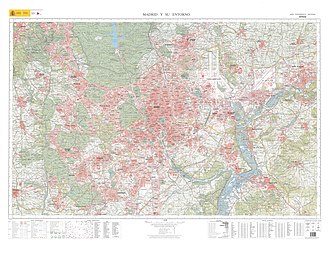
Back Metropolregion ALS Aria metropolitana AN مدينة كبرى Arabic مدينه كبرى ARZ Área metropolitana AST Aqlomerasiya regionu AZ Wawengkon métropolitan BAN Kadakulaan na rona BCL Метрополен регион Bulgarian महानगरीय क्षेत्र BH
This article needs additional citations for verification. (October 2021) |


| Ekistics |
|---|
| Terms |
| Lists |
|
|
A metropolitan area or metro is a region consisting of a densely populated urban agglomeration and its surrounding territories which share industries, commercial areas, transport network, infrastructures and housing.[1][2] A metropolitan area usually comprises multiple principal cities, jurisdictions and municipalities: neighborhoods, townships, boroughs, cities, towns, exurbs, suburbs, counties, districts and even states and nations in areas like the eurodistricts. As social, economic and political institutions have changed, metropolitan areas have become key economic and political regions.[3]
Metropolitan areas in the United States are delineated around the core of a core based statistical area which is defined as an urban area, (this is different than the urban core) and consists of central and outlying counties, as the terms central city and suburb are no longer used by the census bureau due to suburbanization of employment.[4][5][6] In other countries metropolitan areas are sometimes anchored by one central city such as the Paris metropolitan area (Paris). In other cases, metropolitan areas contain multiple centers of equal or close to equal importance, especially in the United States; for example, the Dallas–Fort Worth metropolitan area has eight principal cities. The Islamabad–Rawalpindi metropolitan area in Pakistan, the Rhine-Ruhr in Germany, and the Randstad in The Netherlands are other examples.[7]
In the United States, the concept of metropolitan statistical areas has gained prominence. The area of the Greater Washington metropolitan area is an example of statistically grouping independent cities and county areas from various states to form a larger city because of proximity, history and recent urban convergence. Metropolitan areas may themselves be part of a greater megalopolis. For urban centres located outside metropolitan areas that generate a similar attraction at a smaller scale for a region, the concept of a regiopolis and a respective regiopolitan area, or regio, was introduced by German professors in 2006.[8] In the United States, the term micropolitan statistical area is used.
- ^ Loibl, Wolfgang; Etminan, Ghazal; Gebetsroither-Geringer, Ernst; Neumann, Hans-Martin; Sanchez-Guzman, Santiago (2018). "Characteristics of Urban Agglomerations in Different Continents: History, Patterns, Dynamics, Drivers and Trends". Urban Agglomeration. doi:10.5772/intechopen.73524. ISBN 978-953-51-3897-6.
- ^ Squires, G. Ed. Urban Sprawl: Causes, Consequences, & Policy Responses. (The urban Institute Press (2002)
- ^ Mark, M.; Katz, B; Rahman, S.; Warren, D. (2008). "MetroPolicy: Shaping A New Federal Partnership for a Metropolitan Nation" (PDF). Brookings Institution. pp. 4–103.
- ^ "Federal Register" (PDF). Office of Management and Budget. Retrieved October 5, 2023.
- ^ "Urban cores, Core cities and Principal cites". new geography.com. Retrieved October 5, 2023.
- ^ "Definition of Urban Terms" (PDF). demographia.com. Retrieved 22 October 2013.
- ^ "List 2. Principal cities of metropolitan and micropolitan statistical areas, march 2020". Archived from the original on 2022-03-31.
- ^ Iris Reuther (FG Stadt- und Regionalplanung, Universität Kassel): Presentation "Regiopole Rostock". 11 December 2001, retrieved 13 June 2009 (pdf).